Treating and Preventing
Common Elbow Problems
(Part 2) |
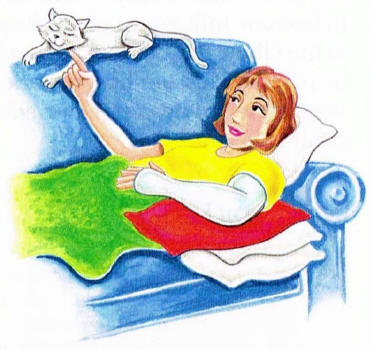
Fractures
A fracture is a crack or break in a bone. You might fracture your
elbow
by falling on it or by trying to break a fall with your hand. If you
suspect
you might have fractured your elbow, get medical help as soon as you can.
Some fractures require surgery to fix, others don't. Rehabilitation
(physical therapy or occupational therapy) may help you get better faster.
Most Common Types of Fractures
Bones
break in many ways. The two most common elbow breaks are
hairline fractures and displaced fractures. Displaced fractures
often require surgery.

Any Bone Can Break
The
radius fractures most often, but any of the three bones that meet
in your elbow can fracture. Any bone can have any type of fracture.

|
First Steps
First, put
ice on your elbow right away. This will reduce pain and help prevent
swelling. Second, get medical attention quickly. Healthcare
providers will:
●
Make images of your elbow, such as an x-ray,
CT scan or MRI, to find the location and severity
of the fracture.
●
Put a splint or a cast on your arm to hold the
elbow still so the bone can heal. You may
also
be told to keep your arm in a sling for a period
of time.
|
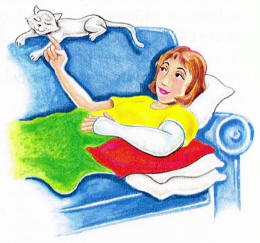
|
Further Treatment
Your
healthcare provider may recommend one or more of the following:
●
Keeping your elbow elevated when you are lying
down.
●
Medication for pain and inflammation to make
you more comfortable as you heal.
●
Surgery for a displaced fracture. The surgeon
may repair the bone, remove loose pieces of
bone or use pins, screws or wires to hold the
pieces in place to heal.
●
Rehabilitation to get your elbow back in business.
|
Life with a Cast
If your arm
is put in a cast, protect the cast so it can protect your arm. You
may be told to:
●
Keep it dry. If you must go out into the rain or
snow, wrap the cast in plastic bags.
●
Don't
put objects into the cast. If your arm itches,
blow cool air in with a hair dryer.
●
Call your healthcare provider right away if you
have tingling, numbness, swelling or extreme
pain.
Call also if your fingers change color or feel
very
cold. If the cast feels much too tight, much
too loose or hurts, call your healthcare provider.
|
Exercises to Get Going Again
Sooner or
later you may be given exercises such as these. They are to strengthen
your muscles and get your arm back to its full range of motion. Keep
up your exercises at home. Make sure you understand all the motions of
each exercise before leaving the healthcare provider's office. Follow
all the instructions you are given.
|
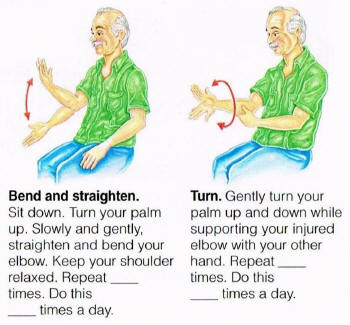
|
|
Bursitis
The tip of
the elbow has a small cushion called the
bursa
to protect the soft tissue from injury.
Overuse, bumps or injuries can cause the bursa to become inflamed and
swollen.
It can even become infected. The skin at the elbow may get red and
feel warm
to the touch, and the area may be painful. This condition is called
bursitis.
Treatment can stop the pain. Wearing a pad on your elbow
when needed can keep bursitis from coming back.
|

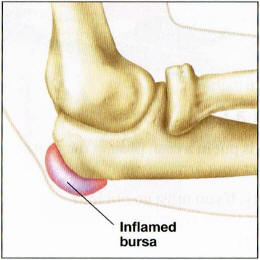
If inflamed, the bursa can swell
to many times its original size.
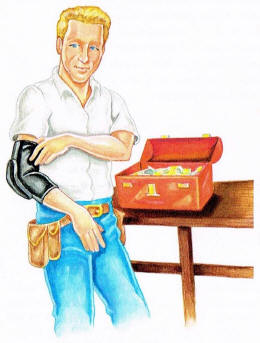
|
First Steps
When your
elbow hurts, rest it as much as you can. Put ice and an elastic
wrap on it to help reduce the swelling and pain.
●
Put a cold pack on it for 15 or 20 minutes at a
time, 3 or 4 times a day, or as directed by your
healthcare provider.
●
Always protect your skin by wrapping the cold pack
with a thin cloth.
Further Treatment
The bursa
may respond to injury by filling with too much fluid. This is why
it swells. Left untreated, that excess fluid may become infected.
Your doctor may:
●
Inject your bursa with cortisone to help relieve
inflammation.
●
Prescribe antibiotics or anti-inflammatory
medications.
●
Have you wear an elbow wrap or splint for a while
to keep your arm still.
●
Remove (aspirate) the excess fluid, which may be
tested for infection.
Preventing Future Problems
To keep
bursitis from coming back, wear an elbow pad during activities in which
you might bump the tip of your elbow. Try to vary your activities.
|
|
Cubital
Tunnel Syndrome
The ulnar nerve passes near
the tip of the elbow through a small space called
the cubital tunnel.
Overuse of or injury to the elbow can cause inflammation
of this nerve. This is called cubital tunnel syndrome (also known as
ulnar neuritis,
or ulnar nerve entrapment). Your elbow may ache. Your ring
finger and little finger
may tingle or feel numb. If this condition is not treated, permanent
nerve damage may result.
|
|

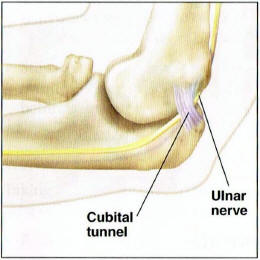
The ulnar nerve passes through the
cubital tunnel, a small opening in the elbow.
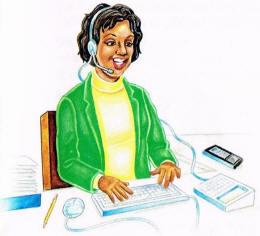
|
First Steps
To reduce
swelling and pain, stop doing what caused the problem. If you
can't stop, limit the activity as much as possible. Medications
may be recommended to help relieve pain and inflammation. A nerve
conduction study (NCS) may be done to help diagnose the problem.
NCS measures how quickly mild electrical pulses travel through your arm.
Further Treatment
If the
problem persists, try to avoid bending your elbow as much as you can.
You may be asked to:
●
Try to keep your hand in a neutral (handshake)
position, rather than turned up or down, while
using the
arm.
●
Wear a splint or towel around your elbow at night
to keep it straight while you sleep.
●
Have an injection of cortisone to reduce
inflammation.
●
Have surgery to reduce pressure on the nerve.
Preventing Future Problems
It may be
enough just to avoid leaning on or bending your elbow for long periods.
If you must lean on the elbow, wear a pad to reduce pressure on the
nerve. Try a telephone headset instead of bending your elbow to
hold the phone to your ear. Vary activities so you don't overdo
any one thing with your arm.
Other Nerve Problems
The ulnar
nerve is only one of the nerves that passes through your elbow.
Other elbow nerves may also be irritated and cause problems.
|
|
Use Your
Elbow Wisely
Your elbow is designed to do
a wide variety of activities. It is not made to do any
one thing over and over. Yet work and play often mean doing the same
movement
for long periods. To protect your elbow, try to avoid doing the same
motions and
remaining in the same posture without a break. Do exercises as
directed. And any
time you do tasks in which your elbow is likely to get bumped, wear an
elbow pad.
|



![]()
![]()